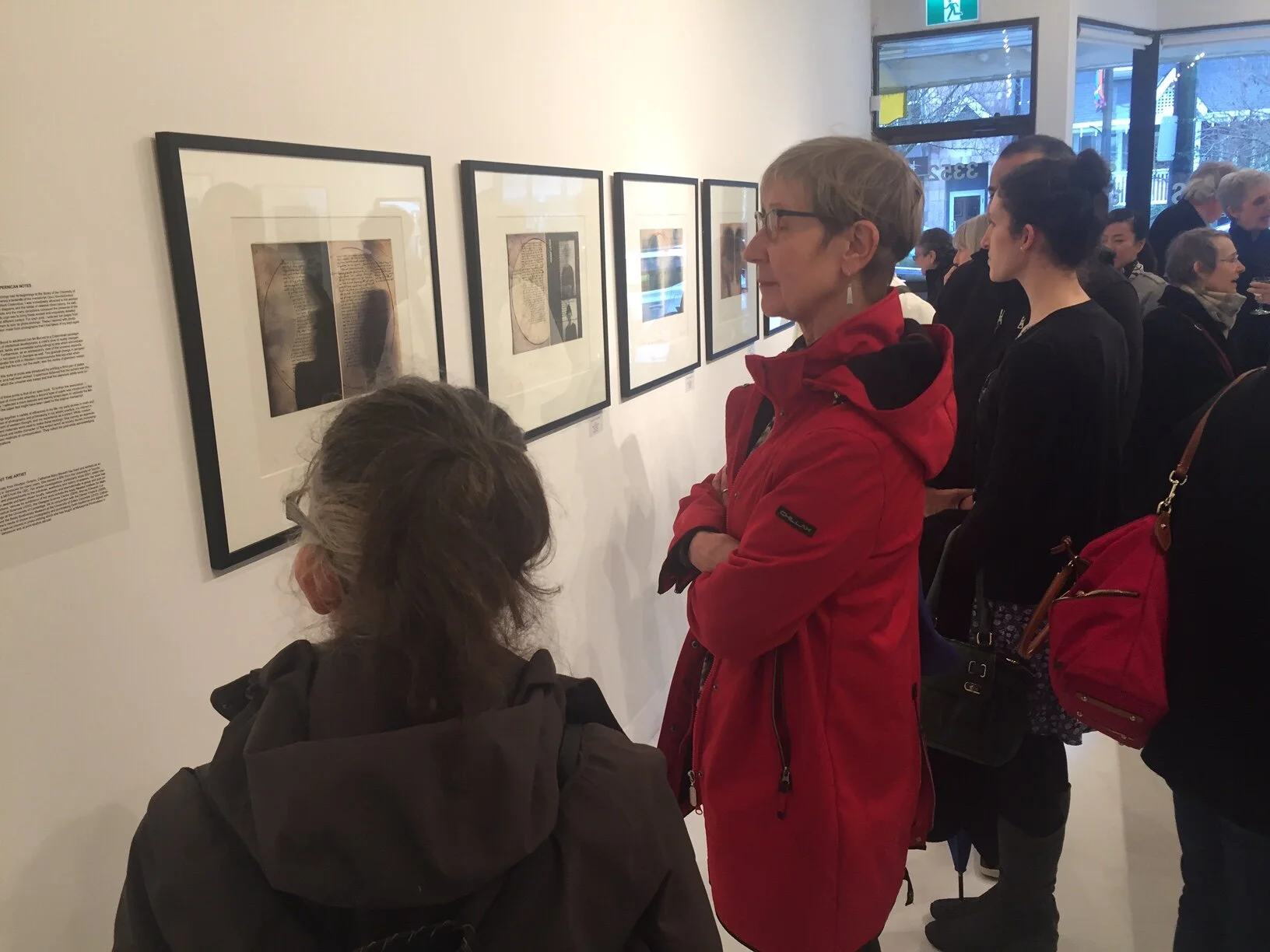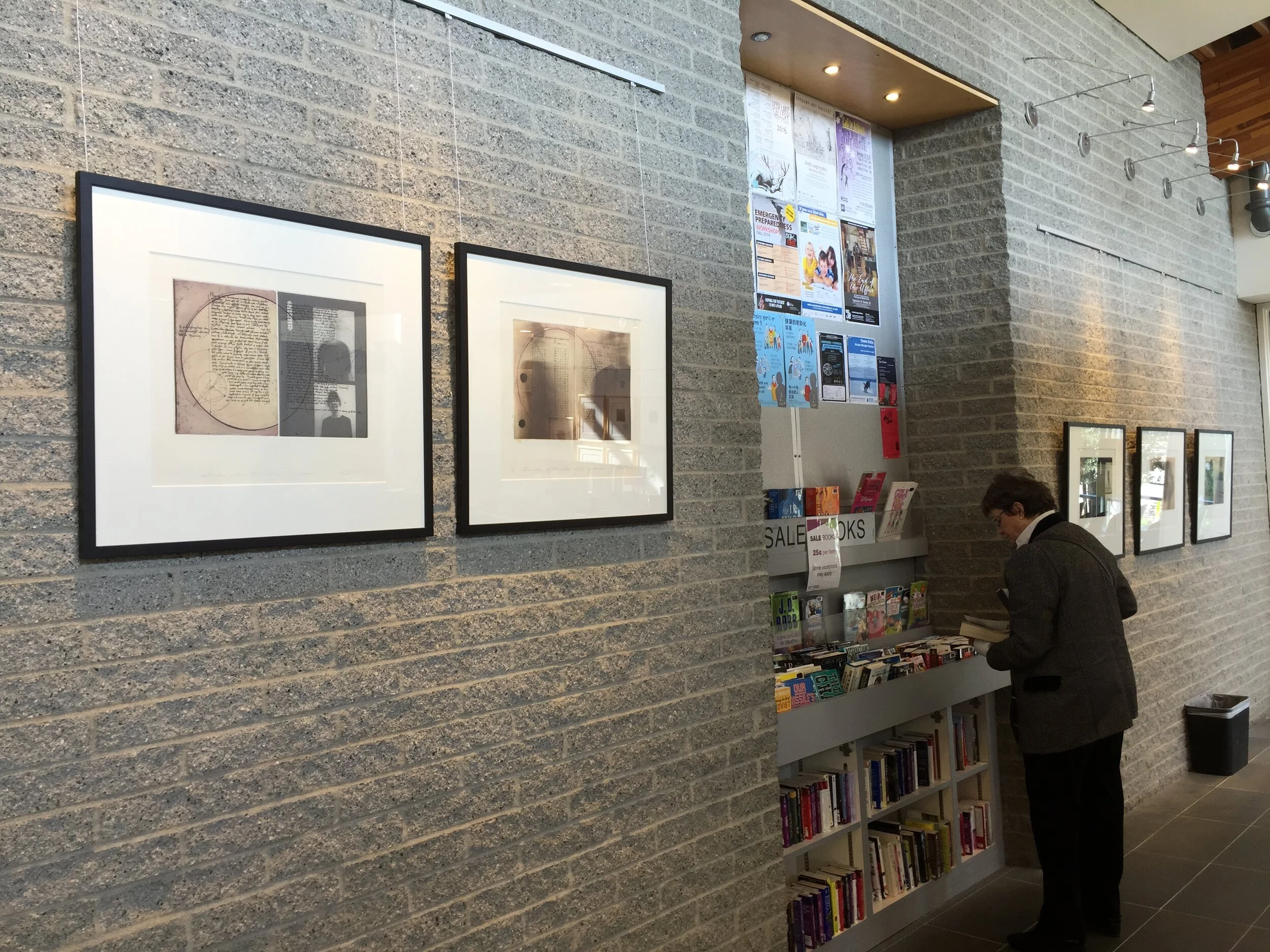Copernican Notes
Anomalies of the Motion of the Equinoxes
Photo-etching with chin-collé
27.5x39 cm
This suite of multiple plate etchings had its beginnings at the library of the University of British Columbia. When I opened a facsimile of the manuscript Opus Revolutionibus Caelestibus (1543) by Nicholaus Copernicus, I was immediately attracted to the penned Latin script, the hand drawn diagrams and the tables of celestial observations. My urge was to bring these ancient and exquisitely detailed pages to light in a new and different context.
For each print, I selected two pages from the Copernican text and reproduced them to size using photopolymer film adhered to zinc etching plates. I prepared a second pair of plates with figures in motion and a third pair into which circles or arcs had been etched in the traditional manner. Using a different colour of ink for each pair of plates, I printed them consecutively, one on top of the other, thus allowing a richly toned and textured image to emerge.
(Read full artist’s statement at the end)
Complexities of the Motion of Venus
Photo-etching with chin-collé
27.5x39 cm
Foundation for a Paradigm Shift I
Photo-etching with chin-collé
27.5x39 cm
Deriving the Motions of Saturn and Jupiter III
Photo-etching with chin-collé
27.5x39 cm
Investigating the Motion of Venus
Photo-etching with chin-collé
27.5x39 cm
Foundation for a Paradigm Shift II
Photo-etching with chin-collé
27.5x39 cm
Similar Arcs of Parallel Circles
Photo-etching with chin-collé
27.5x39 cm
The Order of the Heavenly Spheres
Photo-etching with chin-collé
27.5x39 cm
Installation view
Edinburgh Print Gallery
Installation view
Visual Space Gallery opening
Installation view
McGill Library, Burnaby Art Gallery offsite exhibition
Installation view
Nanaimo Art Gallery (group exhibition)
Artist's Statement
This suite of multiple plate etchings had its beginnings at the library of the University of British Columbia. When I opened a facsimile of the manuscript Opus Revolutionibus Caelestibus (1543) by Nicholaus Copernicus, I was immediately attracted to the penned Latin script, the hand drawn diagrams and the tables of celestial observations. As well, imperfections such as inkblots and the many corrections conveyed the presence of the writer in a personal way. My urge was to bring these ancient and exquisitely detailed pages to light in a new and different context.
For each print, I selected two pages from the text and reproduced them to size as photo-etchings. These I layered with photo-etchings of figures in motion made from photographs that I had taken of my teen-aged daughter. Another layer of colour, texture and line was introduced by printing a third pair of plates into which circles or arcs had been etched. Copernicus believed that the sphere was the perfect form upon which the universe was based and that the planetary orbits were circular in nature.
The transition from childhood to adulthood can be likened to a Copernican paradigm shift. During this phase of intellectual development, a child’s view of reality changes from one centred on self, family and immediate surroundings to one which encompasses much, much more. Furthermore, as an adolescent’s view of the universe expands, an awareness of his or her place in it changes as well. This gradual change in perspective can be seen to parallel the shift in Western consciousness that occurred when Copernicus established that the sun, not the earth, was the centre of planetary motion as had previously been believed.
This body of work brings together a variety of influences in my life: my early studies in math and physics, the use of photography and printmaking in my artistic practice, my growing interest in the philosophy of science, and my experience as a parent. While contemporary techniques involving photopolymer film and digital imaging were used to make these etchings, they speak of an appreciation for the visual and tactile character of ‘the written word’. The intaglio medium is particularly appropriate for these works as this form of printing, like the Copernican treatise itself, is rooted in the past.
Review by Julia Hawkins on ELEMENTS OF GRACE and COPERNICAN NOTES, Millennium Mathematics Project
Review by Gillian Armitage on ELEMENTS OF GRACE and COPERNICAN NOTES, Chop Newsletter
Copyright © 2022 Catherine M. Stewart. All rights reserved.











